We had no plans for going to Poland (land of pierogies, vodka, and pickles), or Warsaw in particular, on this leg of our travels. But that’s where our new approach to choosing destinations took us. We would have liked to stay longer in Romania, particularly Brasov. However, when we booked our Airbnb there back at the end of May, it was already booked starting August 9. The only other part of Romania that really grabbed us was the Danube Delta, which would have been too hot in August. The search began: where could we go for a reasonable price that was likely to be relatively cool?
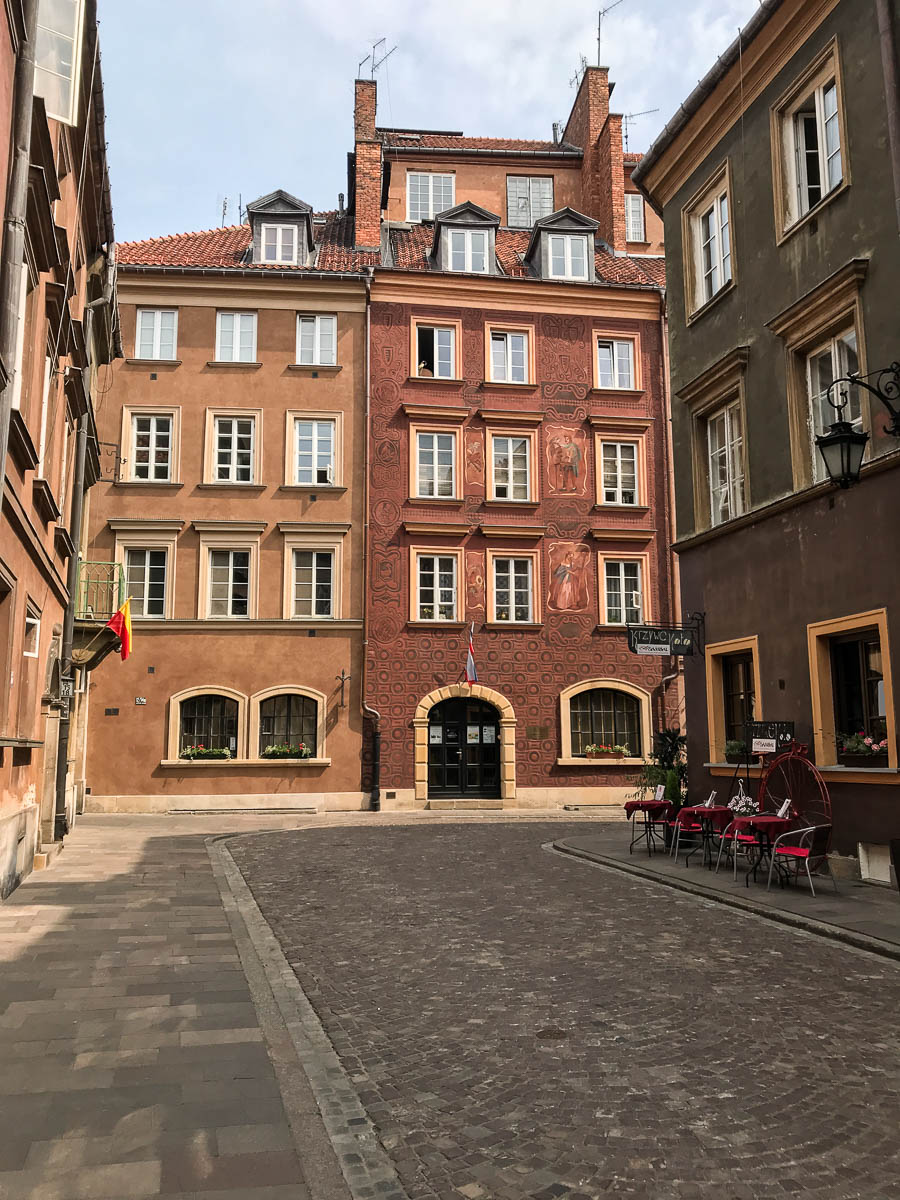
We started looking at places in the north with reasonable prices (thus ruling out Scandinavia). Our top choices would have been Latvia, Lithuania, or Estonia. Alas, no nonstop flights from Bucharest. Then we noticed cheap fares to Warsaw, Poland’s capital city. We had wanted to visit Krakow, Poland’s historical capital, on a much shorter European trip (vacation) about four years ago, but we ran out of time. Airfare directly to Krakow was expensive, but a bit more research revealed inexpensive trains from Warsaw to Krakow. The decision was made.
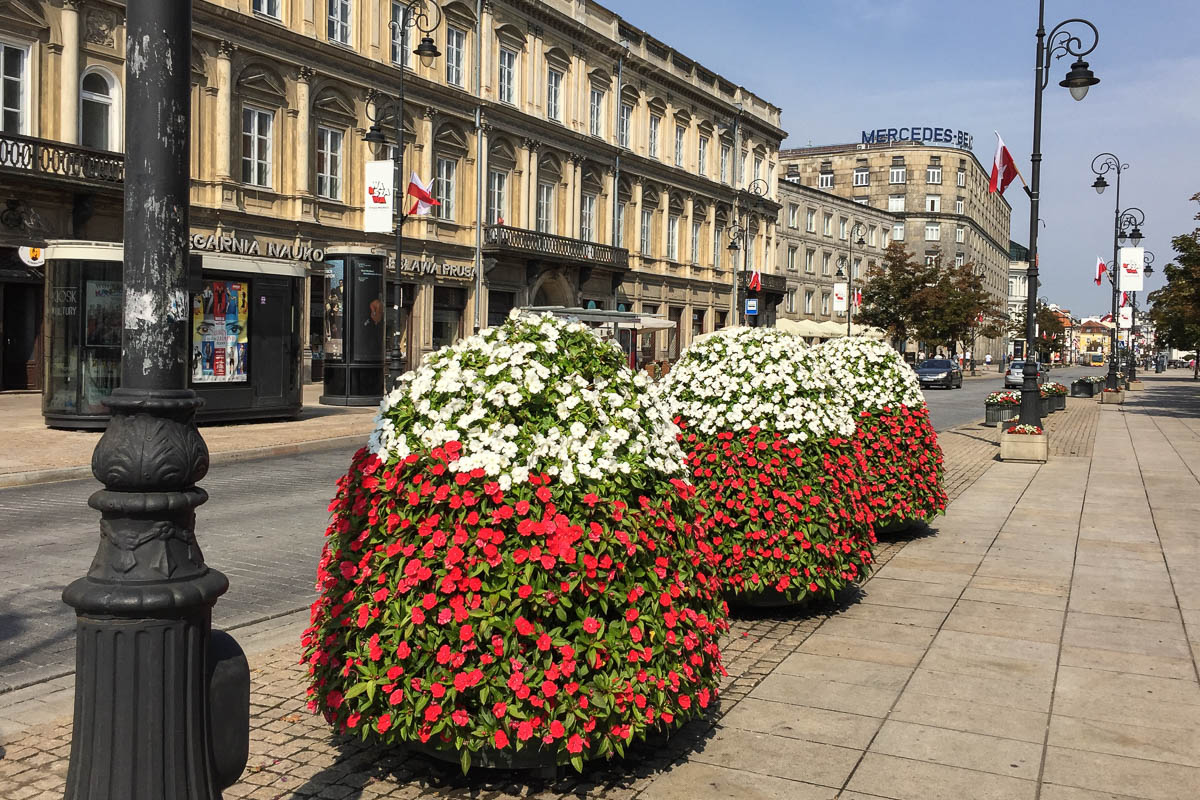
Sinaia, Romania to Warsaw, Poland
We’d arranged an airport shuttle from Sinaia direct to the Bucharest airport, meaning we wouldn’t have to transit Bucharest again. The cost was the equivalent of $15 each. The shuttle company called us the night before to verify that we were still going. Our instructions were to meet the shuttle at the train station at 11:00 am. By noon, no shuttle had appeared, and we were beginning to get a little nervous. Visions of Guatemala were floating through our heads. We were already making backup plans of getting a taxi to the airport for about 75 Euros. Ian phoned the shuttle company and found out that they were about 20 minutes away (the shuttle had started in Brasov). It finally arrived at 12:30 pm. Perhaps because of our Guatemala experience, we’d allowed plenty of time. Our arrival at the airport was perfect timing; check-in for our flight had just opened.
This flight was our first experience with a European ultra-low-cost airline, in this case Wizz Air. We’d read lots of bad things about the airline, but our experience was 100% positive. The plane was on time, it was clean and comfortable, and it arrived safely. When dealing with ultra-low cost airlines we think, its necessary just to play their game and build the extras into the cost. If you don’t pay for the priority service, then carry-ons are not allowed, no advance seat assignment, no airport check-in, online check-in only between 48 hours and 24 hours before flight. But with priority service, we got to board first, could check in up to 60 days ahead, could check a bag and have a carry on, and got to choose exit row seats for a couple of bucks extra. Our total cost for two tickets including the priority service was $169, a bargain.
Arrival in Warsaw
Our first pleasant experience happened at the airport. After going through immigration (with not a word from the officer), we were able to change our leftover Croatian kuna to Polish zlotys. We couldn’t find anywhere in Romania that would change kuna at all, to any currency. So yay!
Since we were in Warsaw for only three days and we had Hilton points that were expiring, we decided to stay at the Hampton by Hilton City Center to keep our Hilton points active. It was $82 per night including a wonderful breakfast buffet. The hotel was in a great location within easy walking distance to Old Town. Plus the main train station, from where we were taking the train to Krakow, was a 5-minute walk. We would highly recommend this hotel for a Warsaw visit.
We could have taken the train from the airport into the city but given that taxis were so cheap, about $10 from airport to our hotel, we went with this easier option. That was after we gave up on Uber after five drivers cancelled on us. The taxi driver was pleasant, totally honest (unlike Granada), and the car was clean.

We knew that almost the entire city was destroyed by the Nazis during World War II. Our preconceived idea of Warsaw was that it was going to be a noisy, ugly, dirty city with Communist towers everywhere. We couldn’t have been more wrong. The city was relatively quiet, clean, modern, with a moderate amount of traffic. The Old Town, while a reconstruction and touristy, was quite charming. The city also has many wide boulevards, part of the Communist rebuilding of the city after the war.
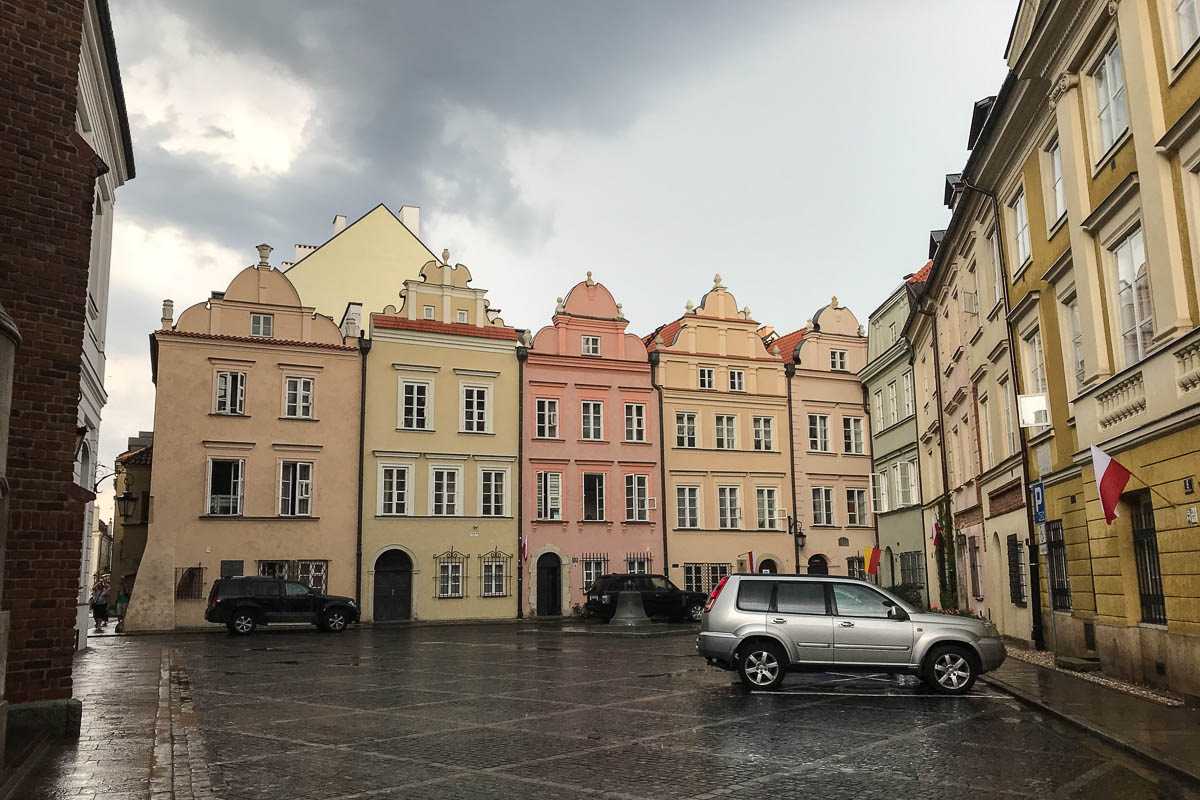
We spent a very nice day wandering around various neighborhoods, dodging rainstorms, which came down fast and furious, and loud.
The Palm Tree in the de Gaulle Roundabout
We walked from our hotel past the Charles de Gaulle Roundabout. Here, a prominent statue of Charles de Gaulle, a gift from the French Government, appears to be walking away from the old Communist Party headquarters. De Gaulle was living in Warsaw in the 1920’s. He played a key role in the successful Battle of Warsaw that stopped Bolshevik forces on their westward march after World War I.
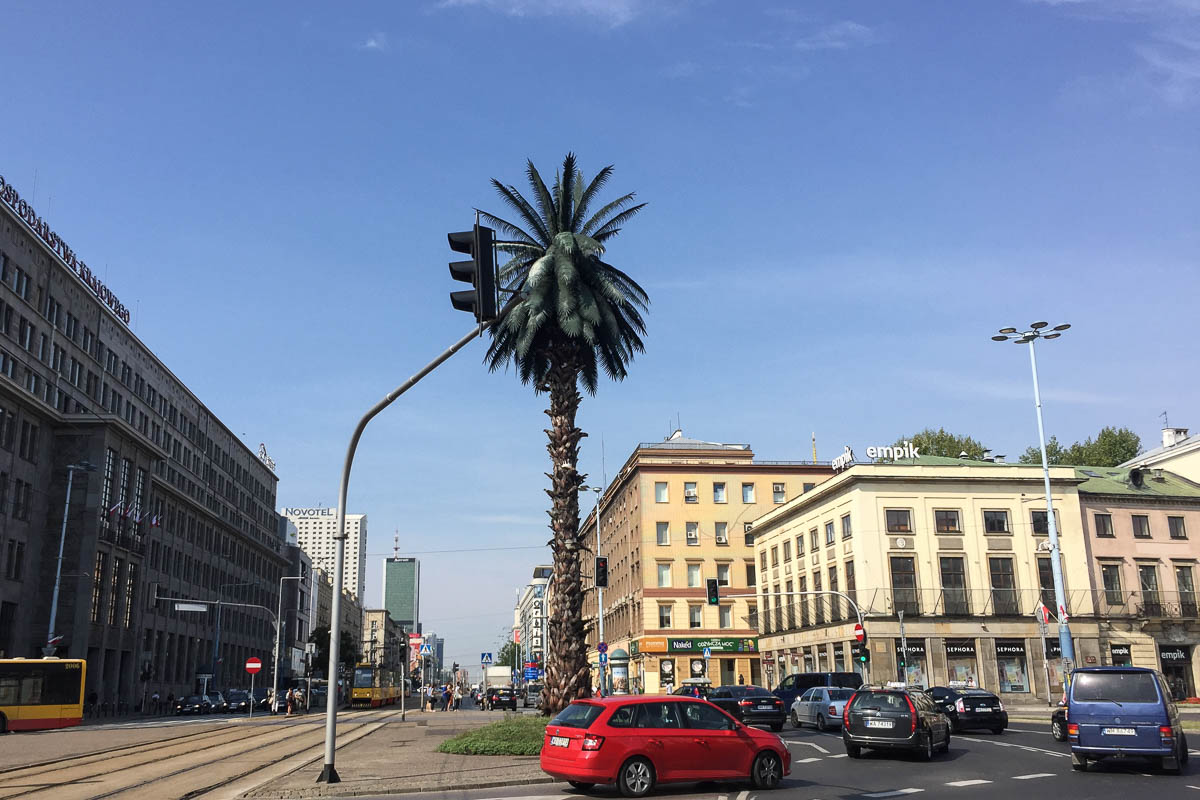
The palm, unveiled in 2002, is not a real tree but an art installation which has become a much-liked symbol by many locals. The tree is titled “Greetings from Jerusalem Avenue” and is the work of Polish artist, Joanna Rajkowska. (Jerusalem Avenue is one of the streets running off the Charles de Gaulle Roundabout. It used to lead to a Jewish settlement called New Jerusalem.) Rajkowska’s palm tree was inspired after a trip to Israel and the reminder of the absence of a Jewish community in Warsaw after World War II. A relevant artist interview from last year can be found here.
Warsaw’s Royal Way and Reconstructed Old Town
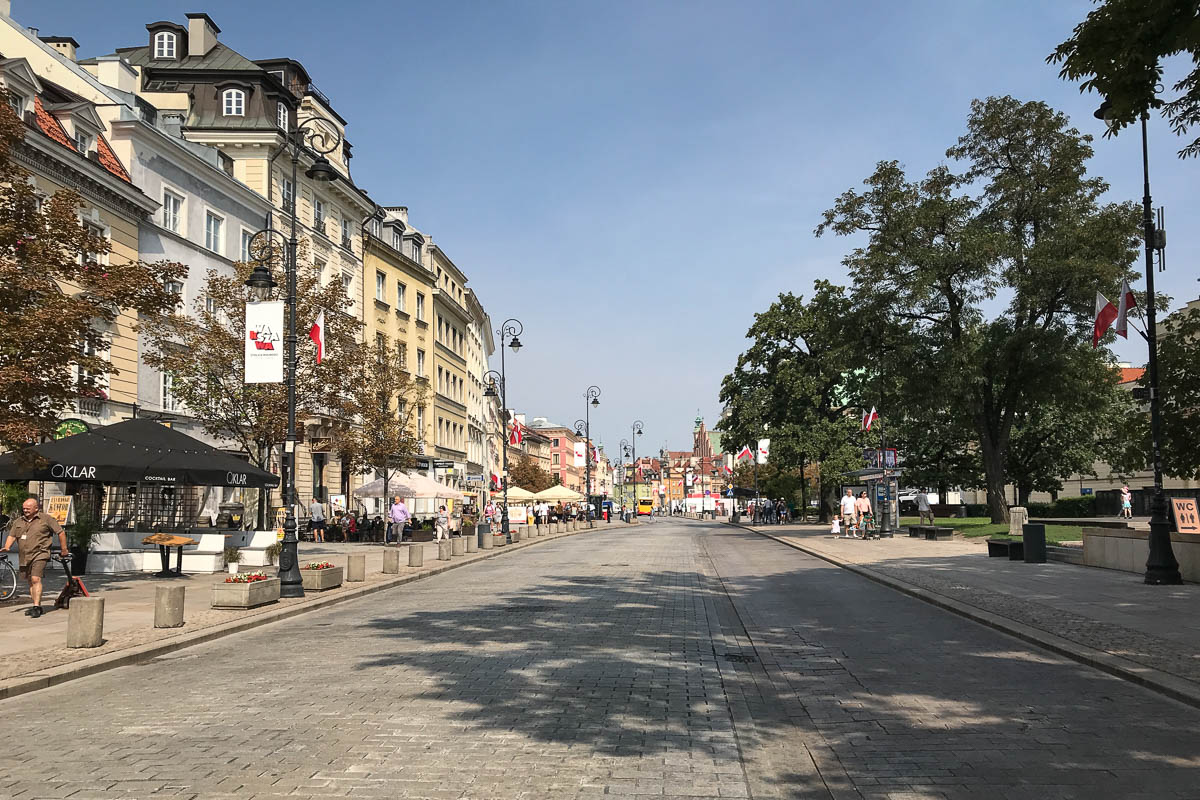
From the Charles de Gaulle Roundabout, we continued walking north onto Nowy Świat, part of the old Royal Way. This was the route that the Polish kings took from their main residence at Castle Square in Old Town to their summer residence. Nowy Świat is clean, primarily pedestrian-only, and lined with shops, cafes and restaurants, plus a few historic sights and museums.
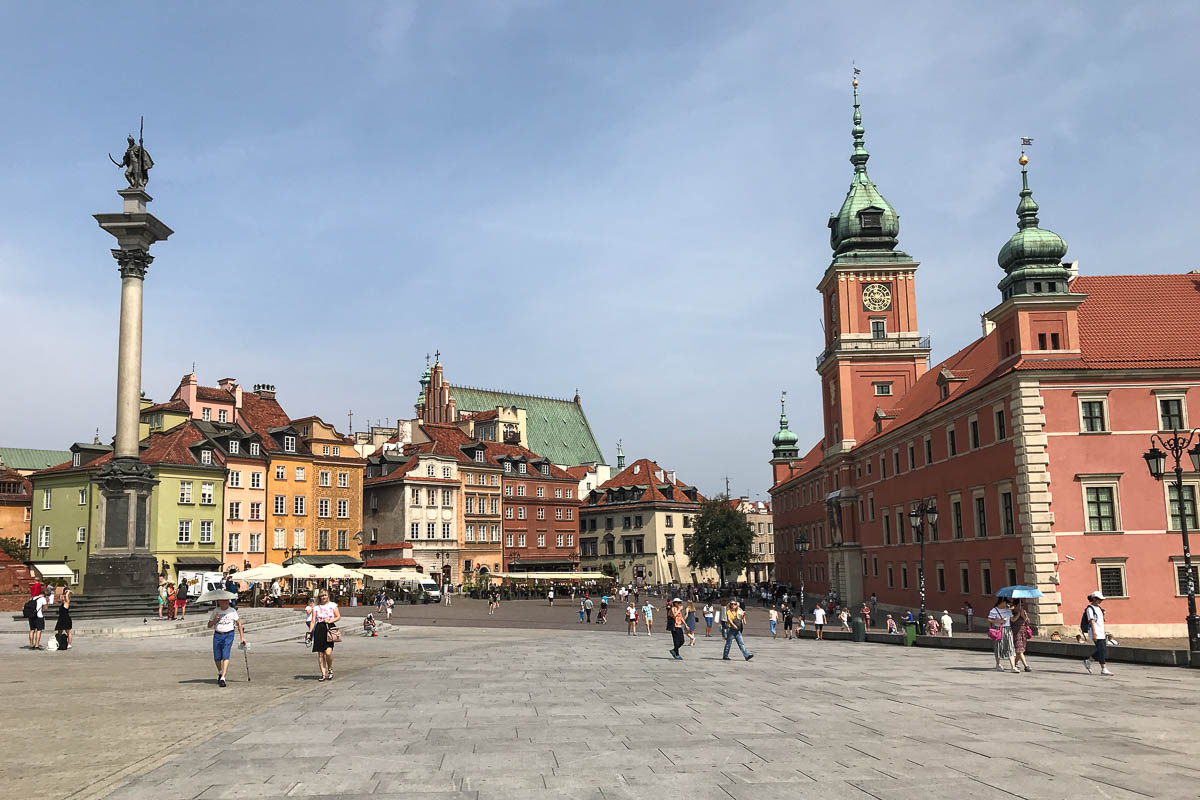
Nowy Świat ends at a large square with a statue of Copernicus. From here, the street name changes to Krakowskie Przedmieście in the heart of the excellently reconstructed Old Town. We wandered pleasantly through the Old Town, with other tourists, but not an excessive number. Among the many historic sights here are several churches.
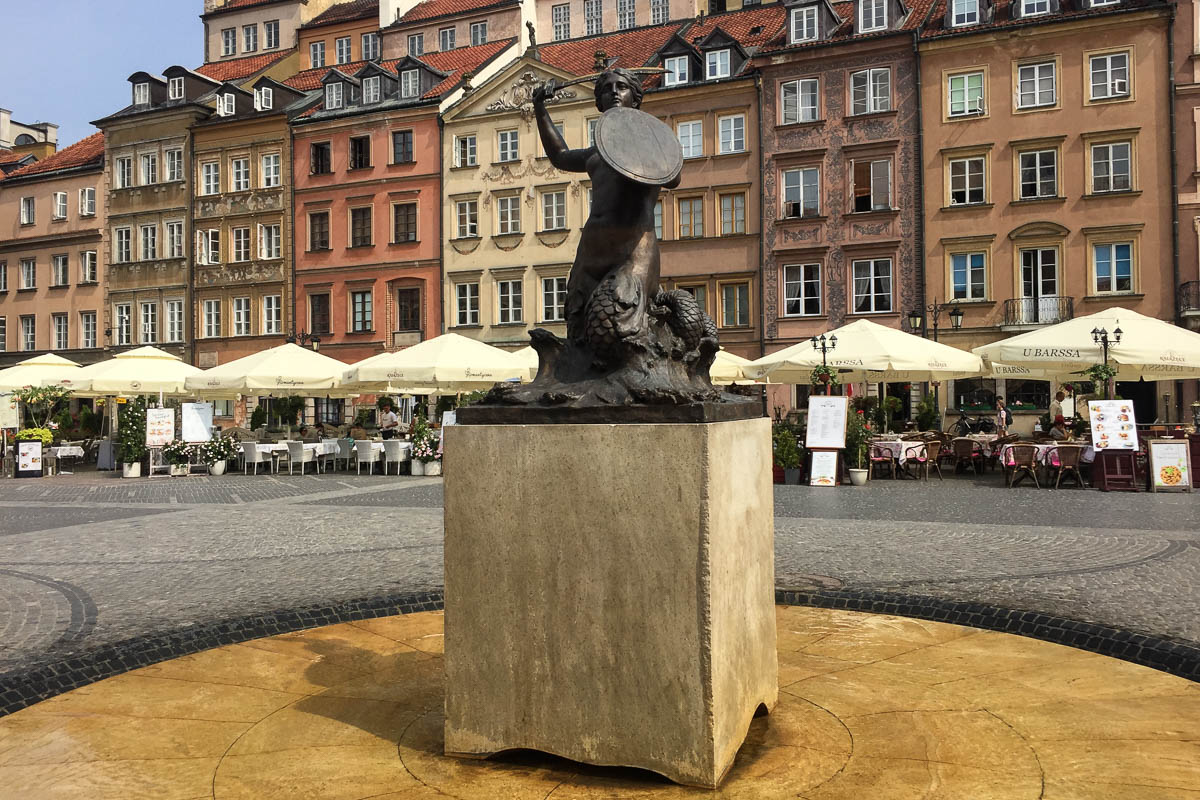
Apparently, Chopin spent the last years of his life in exile in France. His final wish was to have his heart brought back to his home country of Poland. Chopin’s heart is inside one of the pillars in the nave of the Church of the Holy Cross in Warsaw’s Old Town.

Some of the other sights here are Warsaw University, Radziwill Palace, and the Hotel Bristol, to name a few. Radziwill Palace is where the Warsaw Pact was signed in 1955. Hotel Bristol, which survived World War II, was used by the Nazis as a VIP hotel and bordello.

Chopin Benches

One can find black marble Chopin benches along the Royal Way and several other spots around the city. These benches are located in places that somehow played a significant role in Chopin’s life. For example, we saw one of these benches across the street from the house where Chopin’s sister had lived. Simply press the button on the bench, and Chopin’s music fills the air.

Polish Vodka Museum
By now, if you’ve been following our journey, you know we’re probably not likely to pass up an opportunity to visit the Polish Vodka Museum. It was a bit of a ways away, and we needed to cross a long bridge over the Vistula River. The thunderstorms kept threatening, so we decided not to walk. Let’s take a tram; it’s all part of the local experience. Tram tickets can be purchased at kiosks or machines conveniently located along routes. The kiosk with the sign for tickets wasn’t selling them, and the machine didn’t work. (Seeing any similarities to Latin America? We noticed the same in Romania.) So Uber (inexpensive) we did. (Hmm…is Uber a verb?)
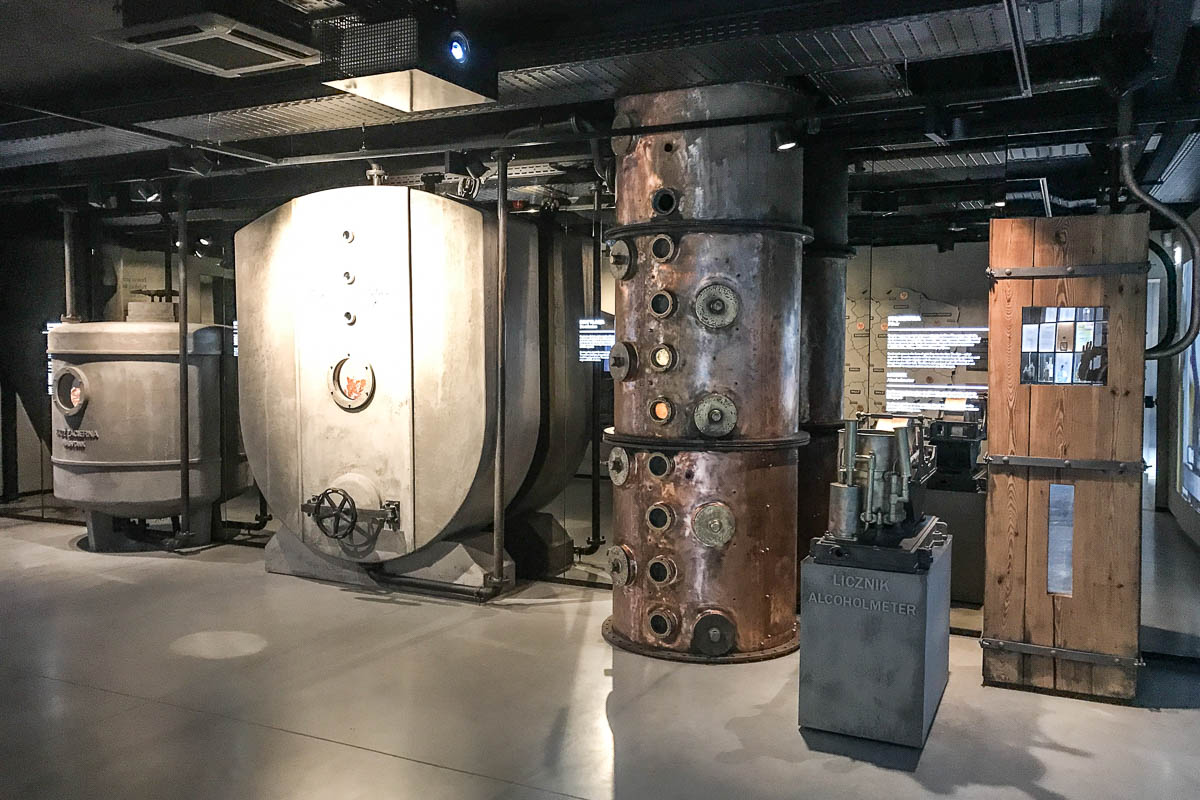
At the state-of-the-art museum with its mandatory guided tour, we learned about the history of vodka in Poland. The first bit of learning was that vodka started in Poland, not in Russia. Vodka production, how vodka is made from different grains (or potatoes), strict rules to be called Polish vodka, and vodka’s role in the lives of the Polish people through history. We even learned about different songs sung when drinking vodka, depending on the occasion. The museum also had a large room beautifully showcasing various vodka bottles throughout history up until the present. We think we recognized the bottle of the Polish rye vodka, Wyborowa, we’d purchased at Trader Joe’s in San Diego – seems like ages ago. And of course, the tour ended with a tasting, comparing rye, potato, and wheat vodkas. Na zdrowie!
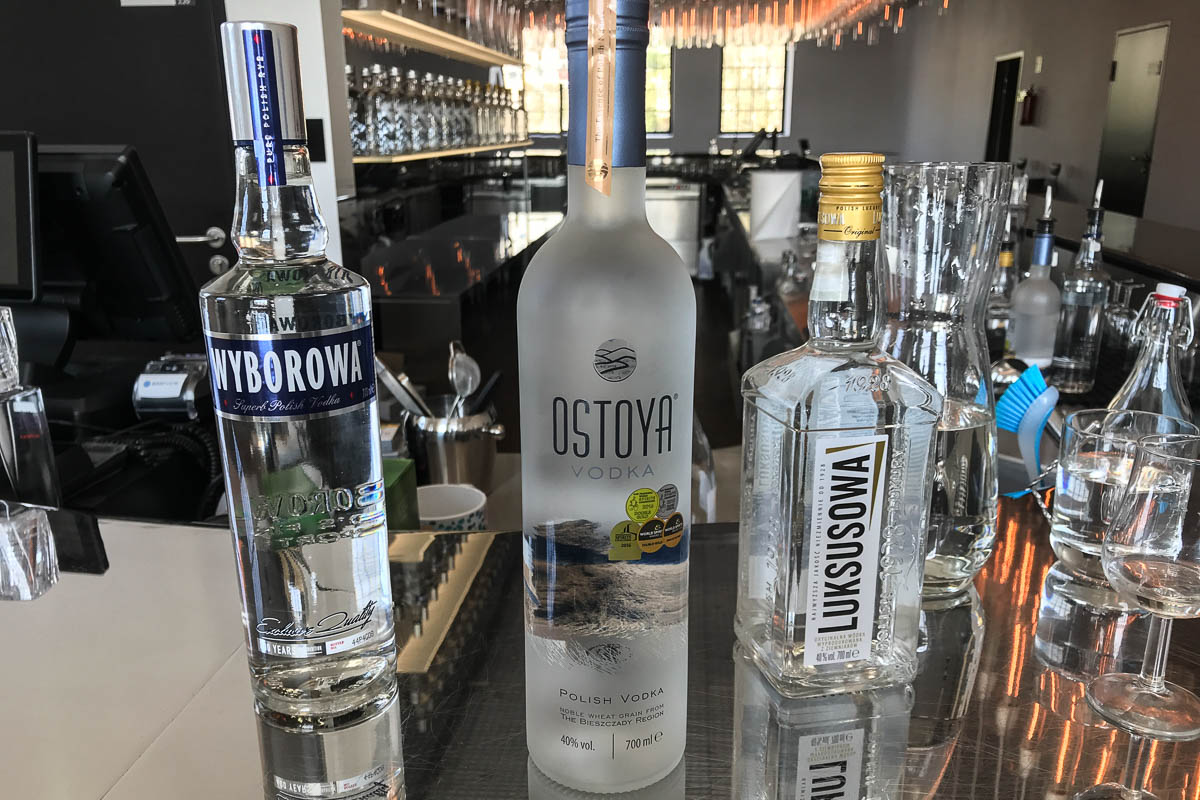
Szarlotka
Szarlotka is a Polish cocktail made with chilled Żubrówka, a Polish vodka flavored with bison grass, apple juice, and a dash of cinnamon. The last is to give it a true apple pie taste. Ann is more of a fan than Ian, who prefers his vodka straight. When in Poland…
POLIN Museum of the History of Polish Jews
The highlight of our time in Warsaw was our visit to the POLIN Museum of the History of Polish Jews . The POLIN opened in 2014 and was awarded the title of European Museum of the Year in 2016. We spent 6 ½ hours in the museum, including a half-hour break in its excellent cafeteria. We could easily see revisiting the museum several times to gain a full interactive appreciation. Admission was 25 zl (PLN)*, 15 zl* with senior discount, plus an optional 10 zl* each for a recommended audio guide.

The POLIN’s Core Exhibition
Through a series of eight galleries, the museum presents the history of Polish Jews through a variety of media. These include artifacts, maps, documents, photographs, quotes, videos, reproductions, interactive displays, and more.
The museum covers 1000 years of Jews in Poland, from the Middle Ages to current day. For many centuries, Jews were key contributors to Poland’s economy and culture. But even throughout these centuries, there were at times anti-Semitic sentiments. The museum does an outstanding job of objectively presenting all aspects of this 1000-year history.
We could write an entire post on the POLIN; instead, above we have supplied the link to the museum’s website. We also welcome your questions and comments. Wikipedia also has a good overview of the history of the Jews in Poland.
Polish Jews – Then and Now
Poland welcomed Jews throughout the country’s history. For centuries, the largest number of Jews throughout the world lived in Poland. Before World War II, Jews comprised 30% of the population of Poland. During the war, the Nazis killed 80% percent of Polish Jews. After the war, the Soviets discriminated against Jews and encouraged them to emigrate, mostly to the US or Israel. (While in Romania, we learned that this forced emigration also occurred there.) After the fall of Communism, there has been a slow revival of Jewish culture in Poland, particularly in Krakow.
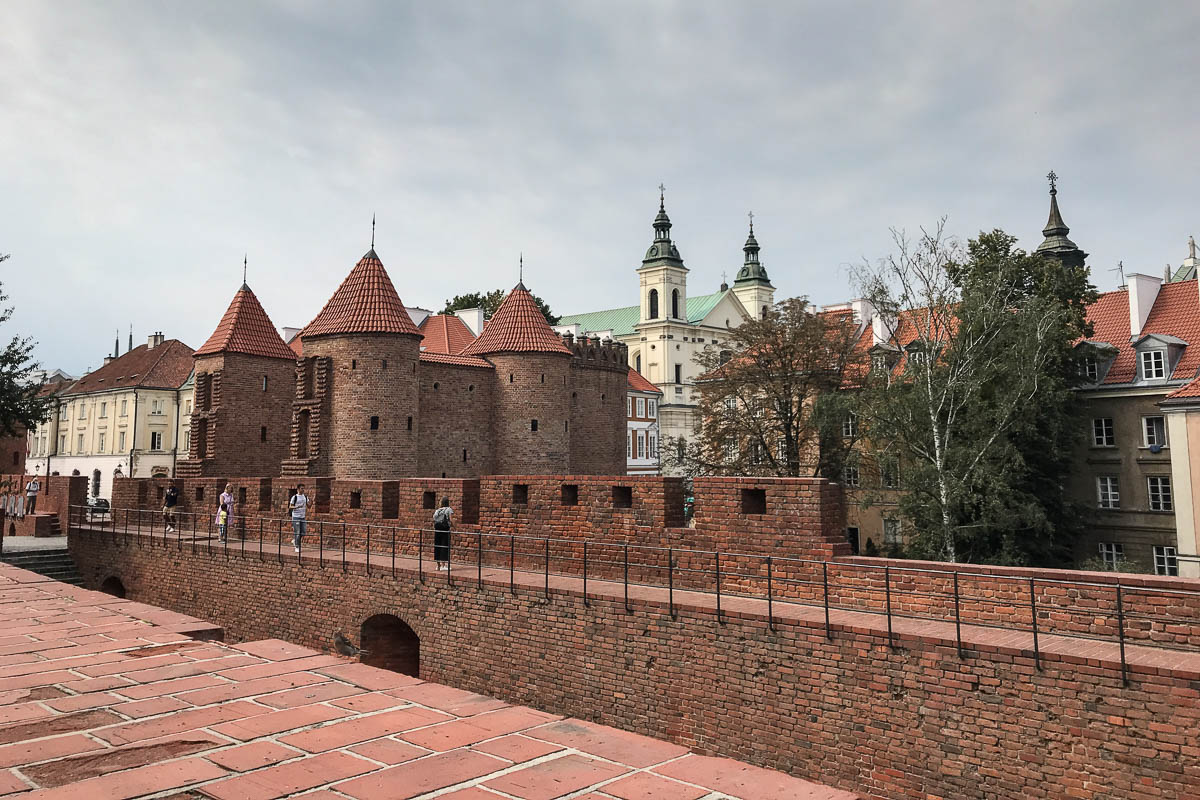
*At time of writing, 1 zl., Polish zloty (PLN), = $ .27
Next Up: Krakow, Poland
Ian & Ann

14 Comments
Beautiful pictures. Brought back wonderful memories.
Hi Marge,
Do you have a favorite picture or special memory from your time in Warsaw?
Ian & Ann
Once again…….amazing! You two are such amazing writers and story tellers and I much enjoy Reading of your travels!
Hi Carrie,
Just yesterday, we were discussing how we think that you could travel the way we do.
Ian & Ann
Again, well done!
See you soon
Hi Art,
Looking forward to seeing you and Ellie.
Ian & Ann
You are giving me the gift of exploring with you, through your pictures & commentaries.
Hi Carol,
And it’s because of you and your travels that Romania, where we were before Poland, was even on our radar. Thanks!
Ian & Ann
I want to see Warsaw too!
Hi Karen,
You should visit! And Krakow too. Both are interesting cities and not too expensive. And you could include Romania on that trip, only an hour and a half flight.
Ian & Ann
I was in Krakow and Warsaw singing with the La Jolla Symphony Chorus in 2001. Your photos are wonderful and brought back memories.
Hi Ellie,
We are curious, how crowded with tourists was it back then?
Ian & Ann
Once again, thank you for an excellent description of your Polish adventures.
A warrior mermaid as a city patron….. a little weird… but OK….
Hi Den,
Apparently, at least three different legends tell how and why the mermaid became the symbol of Warsaw. If you are really curious, you can read about them here: https://www.inyourpocket.com/warsaw/The-story-of-Syrenka-The-Symbol-of-Warsaw_71466f
Ian & Ann